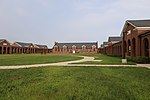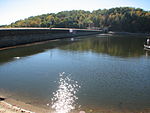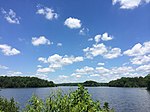Occoquan Reservoir is a 2,100-acre (850 ha) reservoir in northeast Virginia, southwest of Washington, D.C., straddling part of the boundary between Fairfax County and Prince William County, west of Alexandria. It is formed by the Occoquan Dam on the Occoquan River .
Managed by the Fairfax County Water Authority, it provides an important water supply to surrounding settlements in northern Virginia, with an output of 17 million US gallons a day (64,000 m3/d) to 1.2 million people, including over half of the population of Prince William County. The Occoquan Reservoir is officially under Prince William County, despite being on the border with Fairfax County. The major drainages tributary to the Occoquan Reservoir can be divided into two principal sub-basins: Bull Run and Occoquan Creek.Despite being a major fresh water source, Occoquan Reservoir is listed on Virginia's Dirty Water List, with recorded high levels of phosphorus, turbidity, low dissolved oxygen, the presence of copper sulfate and the growing presence of pharmaceuticals, largely due to human land uses, population pressure and poor management. In 1968, the Virginia State Water Control Board (SWCB) commissioned a study of the Occoquan Reservoir and its tributary streams to draw up a plan of sustainable management for the reservoir. A 1970 analysis stated that the reservoir was "highly eutrophic...", and further, that "the sewage plant effluents are mainly responsible for the advanced stage of eutrophication occurring...". As a result, in 1971, A Policy for Waste Treatment and Water Quality Management in the Occoquan Watershed was approved by the SWCB.











